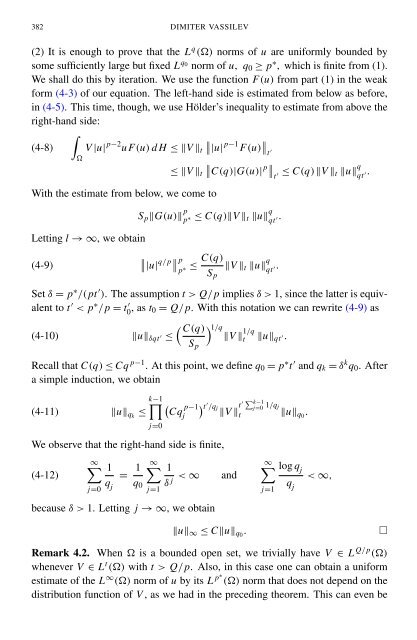Regularity near the characteristic boundary for sub-laplacian operators
Regularity near the characteristic boundary for sub-laplacian operators
Regularity near the characteristic boundary for sub-laplacian operators
Create successful ePaper yourself
Turn your PDF publications into a flip-book with our unique Google optimized e-Paper software.
382 DIMITER VASSILEV<br />
(2) It is enough to prove that <strong>the</strong> L q () norms of u are uni<strong>for</strong>mly bounded by<br />
some sufficiently large but fixed L q 0<br />
norm of u, q 0 ≥ p ∗ , which is finite from (1).<br />
We shall do this by iteration. We use <strong>the</strong> function F(u) from part (1) in <strong>the</strong> weak<br />
<strong>for</strong>m (4-3) of our equation. The left-hand side is estimated from below as be<strong>for</strong>e,<br />
in (4-5). This time, though, we use Hölder’s inequality to estimate from above <strong>the</strong><br />
right-hand side:<br />
∫<br />
V |u| p−2 ∥<br />
(4-8)<br />
uF(u) d H ≤ ‖V ‖ t |u| p−1 F(u) ∥ t ′<br />
<br />
With <strong>the</strong> estimate from below, we come to<br />
Letting l → ∞, we obtain<br />
(4-9)<br />
≤ ‖V ‖ t<br />
∥ ∥ C(q)|G(u)| p∥ ∥<br />
t ′ ≤ C(q)‖V ‖ t ‖u‖ q qt ′ .<br />
S p ‖G(u)‖ p p ∗ ≤ C(q)‖V ‖ t ‖u‖ q qt ′ .<br />
∥ |u|<br />
q/p ∥ ∥ p p ∗ ≤ C(q)<br />
S p<br />
‖V ‖ t ‖u‖ q qt ′ .<br />
Set δ = p ∗ /(pt ′ ). The assumption t > Q/p implies δ > 1, since <strong>the</strong> latter is equivalent<br />
to t ′ < p ∗ /p = t ′ 0 , as t 0 = Q/p. With this notation we can rewrite (4-9) as<br />
( C(q)<br />
) 1/q‖V<br />
1/q<br />
(4-10) ‖u‖ δqt ′ ≤<br />
‖ t ‖u‖ qt ′.<br />
S p<br />
Recall that C(q) ≤ Cq p−1 . At this point, we define q 0 = p ∗ t ′ and q k = δ k q 0 . After<br />
a simple induction, we obtain<br />
k−1<br />
∏ ( p−1) t<br />
(4-11) ‖u‖ qk ≤ Cq ′ /q ∑ j<br />
j<br />
‖V ‖ t′ k−1<br />
j=0 1/q j<br />
t ‖u‖ q0 .<br />
j=0<br />
We observe that <strong>the</strong> right-hand side is finite,<br />
(4-12)<br />
∞∑<br />
j=0<br />
1<br />
= 1 ∑<br />
∞ 1<br />
q j<br />
q 0 δ j < ∞<br />
j=1<br />
and<br />
∞∑<br />
j=1<br />
log q j<br />
q j<br />
< ∞,<br />
because δ > 1. Letting j → ∞, we obtain<br />
‖u‖ ∞ ≤ C‖u‖ q0 .<br />
□<br />
Remark 4.2. When is a bounded open set, we trivially have V ∈ L Q/p ()<br />
whenever V ∈ L t () with t > Q/p. Also, in this case one can obtain a uni<strong>for</strong>m<br />
estimate of <strong>the</strong> L ∞ () norm of u by its L p∗ () norm that does not depend on <strong>the</strong><br />
distribution function of V , as we had in <strong>the</strong> preceding <strong>the</strong>orem. This can even be
















